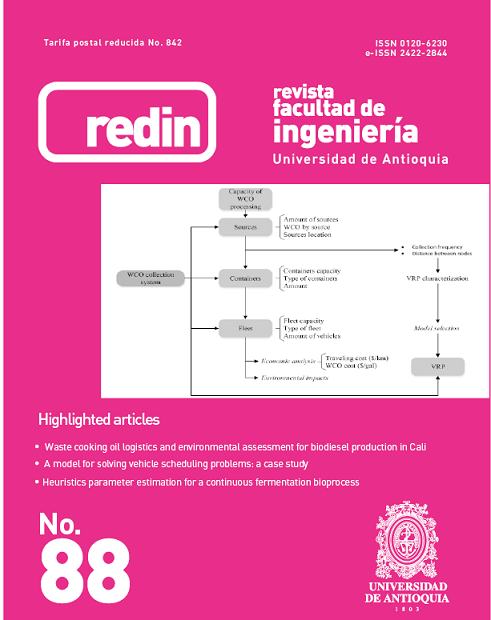Reduction process of low-grade nickel laterite agglomerates using different carbonaceous materials
DOI:
https://doi.org/10.17533/udea.redin.n88a07Keywords:
chemical properties, chemical process, nickel minerals, organic compounds, reducing gasAbstract
Lateritic nickel ores need to be reduced to obtain direct reduced iron and nickel alloy. During processing of lateritic nickel ores in rotary kilns, there is a great loss of fines of ores due to degradation during transport into the reactor. These fines contain substantial amounts of nickel and iron, which could be recovered if they are agglomerated and fed back to the process. It is important to note that the processing of minerals with smaller particle sizes yields more efficient reduction processes because there is more surface area for the reducing agent to react with the mineral particles. This work involves the agglomeration of lateritic ore with a nickel content of 1.78%. Briquettes of 10 g were manufactured with the addition of various carbonaceous materials, such as coal, molasses, and coke, with a ratio of carbon/oxygen = 1. These samples were subjected to temperatures of 1100 °C to reduce the iron and nickel oxides present. The reduction percentages were obtained and the products were analyzed by X-ray diffraction (XRD), atomic absorption, thermogravimetry, and scanning electron microscopy to observe the effectiveness of the reducing agent. The highest reduction percentages (95%) were obtained when molasses was used as the reducing agent.
Downloads
References
A. D. Dalvi, W. G. Bacon, and R. C. Osborne, “The past and the future of nickel laterites,” in PDAC 2004 International Convention, Trade Show & Investors Exchange, Ontario, Canada, 2004, pp. 1–27.
G. Li, T. Shi, M. Rao, T. Jiang, and Y. Zhang, “Beneficiation of nickeliferous laterite by reduction roasting in the presence of sodium sulfate,” Miner. Eng., vol. 32, pp. 19–26, May 2012.
U. de Planeacion Minero energética UPME, Niquel en Colombia. Bogotá, Colombia: UPME, 2009.
Y. Tanaka, T. Ueno, K. Okumura, and S. Hayashi, “Reaction behavior of coal rich composite iron ore hot briquettes under load at high temperatures until 1400°c,” ISIJ Int., vol. 51, no. 8, pp. 1240–1246, 2011.
M. Liu, X. Lv, E. Guo, P. Chen, and Q. Yuan, “Novel process of ferronickel nugget production from nickel laterite by semi-molten state reduction,” ISIJ Int., vol. 54, no. 8, pp. 1749–1754, 2014.
Z. Yu., M. Wen, L. Yan, and X. Qian, “A green process for recovering nickel from nickeliferous laterite ores,” Trans. Nonferrous Met. Soc. China, vol. 20, no. 1, pp. s65–s70, May 2010.
P. Ji, K. Hyun, and J. Sung, “Use of oxidation roasting to control nio reduction in ni-bearing limonitic laterite,” Minerals Engineering, vol. 71, pp. 205–215, Feb 2015.
D. H. Huang, J. L. Zhang, C. C. Lin, and R. Mao, “Production of ferro-nickel granules from nickel laterite ore/coal composite briquettes by direct reduction,” Beijing Keji Daxue Xuebao/Journal Univ. Sci. Technol. Beijing, vol. 33, no. 12, pp. 1442–1447, Dec 2011.
F. Peñaloza and D. Speciale-Fay, “Obtención de dri a partir de briquetas autoreductoras de concentrado de mineral de laterita ferruginosa,” B.Sc thesis, Universidad Central de Venezuela, Caracas, Venezuela, 2004.
A. Janwong, “The agglomeration of nickel laterite ore,” Ph.D. dissertation, University of Utah, Logan, Utah, United States., 2012.
I. Quaicoe, A. Nosrati, W. Skinner, and J. Addai, “Agglomeration and column leaching behaviour of goethitic and saprolitic nickel laterite ores,” Minerals Engineering, vol. 65, pp. 1–8, Oct 2014.
I. Quaicoe, A. Nosrati, W. Skinner, and Addai, “Agglomeration behaviour and product structure of clay and oxide minerals,” Chem. Eng. Sci., vol. 98, pp. 40–50, Jul 2013.
A. Nosrati, J. Addai, and D. J. Robinson, “Drum agglomeration behavior of nickel laterite ore: Effect of process variables,” Hydrometallurgy, vol. 125–126, pp. 90–99, Aug 2012.
M. R. et al, “Reductive roasting of nickel laterite ore with sodium sulfate for fe-ni production. part i: Reduction/sulphidation characteristics,” Sep. Sci. Technol., vol. 51, no. 8, pp. 1408–1420, Mar 2016.
R. Elliott, C. A. Pickles, and J. Peacey, “erronickel particle formation during the carbothermic reduction of a limonitic laterite ore,” Miner. Eng., vol. 100, pp. 166–176, Jan 2017.
S. C. Díaz, A. Garcés, O. J. Restrepo, M. A. Lara, and J. E. Camporredondo, “Thermodynamic analysis of the reduction process of colombian lateritic nickel ore,” Rev. Metal., vol. 51, pp. 1–8, Dec 2015.
Downloads
Published
How to Cite
Issue
Section
License
Copyright (c) 2018 Revista Facultad de Ingeniería Universidad de Antioquia

This work is licensed under a Creative Commons Attribution-NonCommercial-ShareAlike 4.0 International License.
Revista Facultad de Ingeniería, Universidad de Antioquia is licensed under the Creative Commons Attribution BY-NC-SA 4.0 license. https://creativecommons.org/licenses/by-nc-sa/4.0/deed.en
You are free to:
Share — copy and redistribute the material in any medium or format
Adapt — remix, transform, and build upon the material
Under the following terms:
Attribution — You must give appropriate credit, provide a link to the license, and indicate if changes were made. You may do so in any reasonable manner, but not in any way that suggests the licensor endorses you or your use.
NonCommercial — You may not use the material for commercial purposes.
ShareAlike — If you remix, transform, or build upon the material, you must distribute your contributions under the same license as the original.
The material published in the journal can be distributed, copied and exhibited by third parties if the respective credits are given to the journal. No commercial benefit can be obtained and derivative works must be under the same license terms as the original work.










 Twitter
Twitter